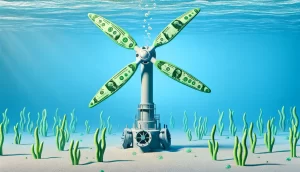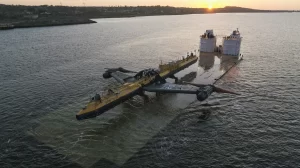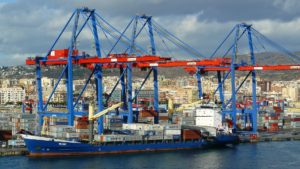In this next installment of Blue Tech Voices we hear from our Blue Economy colleagues down-under. Mark Hemer, acting lead of the Blue Economy Co-operative Research Centre Offshore Renewable Energy Systems Program, answers questions about the new $236 million Blue Economy R&D initiative being stood-up in Australia.
For some quick context, the Blue Economy Co-operative Research Center is a new $236 million government-funded initiative in Australia that aims to bring together expertise in aquaculture, marine renewable energy and marine engineering as part of a single, collaborative project. The 10-year collaboration will involve 45 national and international partners from industry, research and government and is being led by the University of Tasmania. Now, let’s hear what Mark has to say.
The Liquid Grid [TLG]: I think all our readers would agree that Australia has a strong reliance on the ocean, but what led to the creation of the Blue Economy Cooperative Research Center?
Mark Hemer [MH]: The Blue Economy Co-operative Research Center (BERC) brings together three sectors, each with different motivation and levels of maturity, who seek to gain from the benefits of co-location.
Recognising aquaculture as the fastest growing source of protein to meet global food demand, Australia’s aquaculture sector, whose products gather high premiums across the Asia-Pacific region, has tremendous opportunity to expand. However, the sector is encountering competition for coastal space from other sectors. To expand, the aquaculture sector recognises the need to shift operations offshore, but this introduces challenges with regards to land connectivity requirements for electrical power and freshwater.
These challenges present an opportunity for the ocean renewable energy sector that is seeking markets in which to demonstrate and mature their technologies. Such technologies offer a sustainable energy solution to meet the requirements of off-grid, off-shore platforms.
Finally, any new industry in the offshore environment will require transfer of capabilities from the existing offshore engineering sector in order to find new solutions. Environmental, social and regulatory considerations are important factors for each of these sectors and will also be addressed in the BECRC.
The BECRC is based in Tasmania but has a national Australian outlook. Tasmania, with its strong aquaculture industry as well as its robust marine engineering and science capabilities, is a natural home for the BECRC within Australia.
[TLG]: What were the essential elements that brought BECRC to fruition? How did you work with industry or other key stakeholders?
[MH]: The BECRC concept grew from a need to address looming constraints on Tasmania’s seafood production and Australia’s marine renewable energy development pipeline. Recently, these constraints became more important to address with the increasing global awareness of the opportunity for the marine environment to help meet rising demands for sustainable resources, as highlighted by the UN Decade for Sustainable Ocean Development (2021-2030).
There’s also a strong economic justification: the Australian National Marine Science Plan has predicted growth of Australia’s blue economy at a rate approximately double the rest of Australia’s GDP over the next decade. This is in-line with OECD projections of a doubling of the global ocean economy to $3 trillion by 2030.
The BECRC was established to meet the needs of industry. Industrial partners from across three sectors were brought together to identify benefits, opportunities, and common challenges of co-location. The BECRC brings together 45 partners (large industry, SMEs, Government departments and Growth Centres, research organisations) from multiple sectors to make the largest financial contribution (A$330 million) for research within the Australian Government’s Cooperative Research Center Programme. Going forward, projects within the BECRC will align R&D capability with industry identified challenges. All BECRC projects will have at least one industry partner, ensuring close collaboration across all BECRC partners.

[TLG]: There are tons of amazing technologies under development right now, what sectors in the Blue Economy are you most excited to see CRC engage in going forward? Why those sectors?
[MH]: The Blue Economy includes such an amazing range of technologies and industries. One of the strengths of the BECRC, in my opinion, is that we have prioritised some target sectors (e.g., aquaculture, offshore renewable energy, and ocean engineering), but provided a structure that allows R&D outcomes to support a much broader definition of the Blue Economy.
What I find exciting is the exploration of synergies between the sectors involved in the BECRC. For example, the aquaculture sector is in-need of oxygen to improve fish-health in the pens and one way to obtain the needed oxygen is through water electrolysis. This presents an opportunity to demonstrate the use of hydrogen in the offshore energy system. There are many other such synergies that integrate offshore energy conversion technologies into offshore platforms for specific applications.
[TLG]: What’s the longer term vision for the BECRC? How do you see it impacting the local region?
[MH]: The BECRC is a 10-year program which is just getting started. Each of the five BECRC programs have visions for how they will support growth of the Blue Economy in Australia, and internationally, supporting innovation to increase productivity and environmental sustainability while reducing costs. In the Offshore Renewable Energy Systems program, our vision is to support the development of reliable and cost-effective sustainable offshore energy systems that can provide the necessary power for decarbonised offshore industry sectors.
While the BECRC is based in Tasmania, it is a national program, with strong international ties. Australia occupies a unique position in the Asia-Pacific region, and the vision for the BECRC is that this investment in Australian capabilities can help deliver growth in other global Blue Economy markets across the region.
[TLG]: How does the BECRC help the ocean technology startup community? What’s your unique value proposition for the ocean technology community? How is the CRC different in the role that it provides in comparison to other government agencies?
[MH]: Cooperative Research Centres are an Australian Government funded program that support industry led collaborations with researchers and the community. The program has been in place since 1991, and is a proven model for linking researchers with industry to focus on the R&D required for commercialisation. CRC objectives are to improve competitiveness, productivity and sustainability of Australian industries, particularly in areas where Australia has a competitive advantage and are in-line with Australian priorities.
The Blue Economy CRC is the largest CRC that’s even been awarded. This provides some perspective on the opportunity seen for development of ocean technology to support these Blue Economy sectors, from across Australia’s industrial and research communities.
[TLG]: It sounds like the BECRC is an immense opportunity for Australia, and one that I’m sure a lot of marine technology startups would love to get involved with. How can such startups or other companies best work with BECRC going forward?
[MH]: The BECRC is in the process of being established, with partner agreements being negotiated with the 45 partners involved in the initial bid. The immediate interest is establishing projects that support these partners to address the identified challenges that motivated the establishment of the BECRC.
During this period, involvement of other organisations is welcome through third party arrangements, where the involvement of these parties will help address these challenges. In time, we anticipate seeing evolution of the objectives and programs to meet new and emerging challenges that will open opportunities for other partners in the BECRC. We welcome anyone interested to check out our website https://www.blueeconomycrc.com.au and drop us an email at [email protected].

Dr Mark Hemer is the acting lead of the Blue Economy Co-operative Research Centre Offshore Renewable Energy Systems Program. Mark is a Principal Research Scientist at CSIRO – Australia’s national science agency, working in the Oceans and Atmosphere Unit, and Adjunct Associate Professor with the Australian Maritime College, University of Tasmania. His research in offshore renewable energy systems, focussed on offshore sustainability and energy availability, now spans over a decade.




